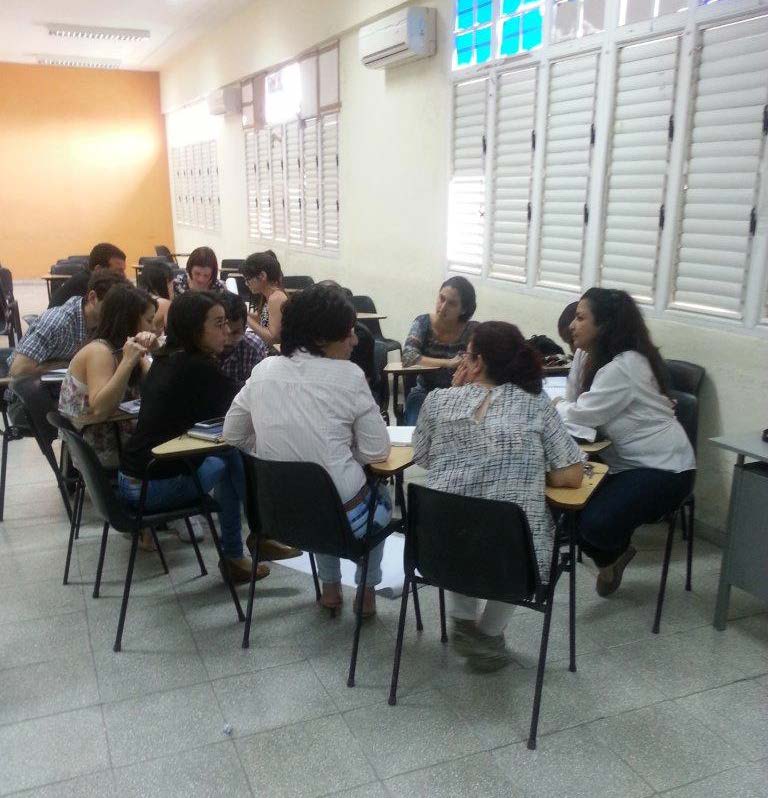Evaluation as a professional performance of the designers.A teaching - research experience.
##plugins.themes.bootstrap3.article.main##
Abstract
The term assessment is widely used in all areas of knowledge, in the most di-verse organizations, and is also a requirement of all programs and scientific projects, however, the design and area of knowledge and as a profession is still a topic insufficiently treated. This paper focuses on the evaluation and mode of action of design professionals and aims to report an educational experience - research that allowed characterize this mode of action from the Appreciative Inquiry approach (A.I.)
The methodology used is as paradigms of research - action - participatory foundations of positive psychology and social constructionism. a qualitative design, consisting of working with a community of practice already established (Group Master of Design Management at the Higher Institute of Design) and directing it towards a learning community assessment was developed. The fundamental organizational form was conducting theoretical workshops - practical. Teaching and research methods were used, those described, with emphasis on the latter, including: participant observation, interviews with focus groups, documentary and product activity analysis and determination of individual and group satisfaction participants.
##plugins.themes.bootstrap3.article.details##

This work is licensed under a Creative Commons Attribution-NonCommercial-ShareAlike 4.0 International License.
- Attribution — You must give appropriate credit , provide a link to the license, and indicate if changes were made . You may do so in any reasonable manner, but not in any way that suggests the licensor endorses you or your use.
- NonCommercial — You may not use the material for commercial purposes .
- No additional restrictions — You may not apply legal terms or technological measures that legally restrict others from doing anything the license permits.
- ShareAlike — If you remix, transform, or build upon the material, you must distribute your contribution under the same license as the original. NOTE: This point applies to numbers 1 to 20 of the magazine with the previous CC-BY-NC-SA 4.0 license. Does not apply to the new CC BY-NC 4.0 license from Volume 11, Number. 21 (2024).
References
ÁLVAREZ DE ZAYAS, CARLOS M. (1994): La escuela en la vida. Editorial Pueblo y Educación, La Habana.
AYALA PÉREZ, J.L. (2013) Universidad de Puerto Rico, Carolina. Medir la creatividad.En diseño gráfico. Gráfica. Documentos de Diseño gráfico. ISSN 2014- 9298.
BEDOLLA, D., GIL, J, RUIZ, A. (2009). El ARS en el estudio y evaluación de metodología para el diseño de productos industriales: Aplicación y perspectiva. REDES- Revista hispana para el análisis de redes sociales. Vol.17, #9.
BELLUCCIA, R. (2007) El Diseño Gráfico y su enseñanza, Ilusiones y desengaños. Editorial. Paidos. Buenos Aires.
CASTRO PIMIENTA, O. (2014) Evaluación Integral. Del paradigma a la práctica. 2da. Edición. Edit. Pueblo y Educación. La Habana.
(2013) Evaluación educativa. ¿Instancia de poder u oportunidad de aprendizaje? Un análisis desde la complejidad. Revista IPLAC. No. 1. Enero – febrero. ISSN: 1993 – 6850. La Habana.
(2016) La modelación de la evaluación desde un enfoque complejo. En Modelos clave para el Diseñador ante los escenarios de cambio. UNAM. Azcapotzalco. ISBN: 9786072806825. México.
y LÓPEZ, C.L. (2009) Evaluación Educativa. Los nuevos retos. Edit. CODEU. Quito.
CHAVES, N. Y BELLUCCIA, R. (2003) La marca corporativa. Gestión de símbolos y logotipos. Paidós, Ed. Buenos Aires.
COSTA, JOAN. (2001) Identidad corporativa. Edit. Trillas. México. Pág. 65.
FRASCARA, J. (2006). El diseño de comunicación. Edit. Infinito. Buenos Aires.
MURANI, B. (2004) ¿Cómo nacen los sueños? Apuntes para una metodología proyectual. 10ma. Reimpresión. Editorial Gustavo Gilí, SA, Barcelona.
NÚÑEZ JOVER, Jorge (2001): “La interdisciplinariedad en la escuela: de la utopía a la realidad”. Curso 01. Evento Internacional de Pedagogía 2001, La Habana.
PEÑA. SERGIO L. (2007). Modelo de Gestión de las Competencias profesionales del Diseño en Cuba. Te- sis de Maestría, ISDi. La Habana.
PEÑA MARTÍNEZ, S.L. Y PÉREZ PÉREZ, M. (2014) La
Utopía del diseño. El Diseño en Cuba. Historia y Realidad. Barbacena. Editora da Universidade do Estado de Minas Gerais.
PEREZ, PÉREZ, M Y PEÑA MARTÍNEZ, S.L. (2014) Diseño: Una definición integradora. Revista A3MA- NOS. No.1. Edit. ISDi. Versión Online ISSN: 2412- 5105. Pág. 21-37.
PEREZ, PÉREZ, M Y PEÑA MARTÍNEZ, S.L. (2015) DISEÑO. El Objeto de la profesión. Revista A3MANOS. No.2. Edit. ISDi. Versión Online ISSN: 2412-510. Pág. 5 – 26.
PÉREZ PÉREZ, M. Y OTROS. (2014) Plan de Estudios (D) de la Carrera de Diseño Industrial. Facultad de Diseño Industrial. Instituto Superior de Diseño. La Habana, Cuba. 2014.
PINO NICÓT, Y. OJEDA HERNÁNDEZ, A. (2014) La evaluación del diseño. Rigor y necesidad. Revista A3MANOS. Edit. ISDi. Versión Online ISSN: 2412- 5105. Pág. 1110-119.
RODRÍGUEZ – MENA, M., CORRAL, R. LÓPEZ, C.L. (2013) Aprender a manejar conflictos a través de las prácticas dialógicas en comunidades de aprendizaje. En Caudales. CIPS. La Habana.
RODRÍGUEZ – MENA, LÓPEZ, C.L., CORRAL, R y otros (2015) La comunidad de aprendizaje“Madiba”. Memorias de un viaje. Ediciones Acuario. La Habana.
TENA PARERA, D. (2008). La investigación en comunicación gráfica. Santa Eulália de Ronsana, Barcelona.






















